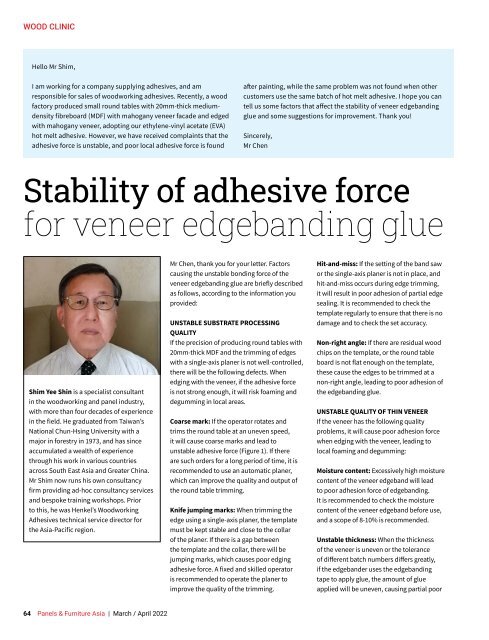Panels & Furniture March/April 2022
Panels & Furniture Asia (PFA) is a leading regional trade magazine dedicated to the woodbased panel, furniture and flooring processing industry. Published bi-monthly since 2000, PFA delivers authentic journalism to cover the latest news, technology, machinery, projects, products and trade events throughout the sector. With a hardcopy and digital readership comprising manufacturers, designers and specifiers, among others, PFA is the platform of choice for connecting brands across the global woodworking landscape.
Panels & Furniture Asia (PFA) is a leading regional trade magazine dedicated to the woodbased panel, furniture and flooring processing industry. Published bi-monthly since 2000, PFA delivers authentic journalism to cover the latest news, technology, machinery, projects, products and trade events throughout the sector. With a hardcopy and digital readership comprising manufacturers, designers and specifiers, among others, PFA is the platform of choice for connecting brands across the global woodworking landscape.
Create successful ePaper yourself
Turn your PDF publications into a flip-book with our unique Google optimized e-Paper software.
WOOD CLINIC<br />
Hello Mr Shim,<br />
I am working for a company supplying adhesives, and am<br />
responsible for sales of woodworking adhesives. Recently, a wood<br />
factory produced small round tables with 20mm-thick mediumdensity<br />
fibreboard (MDF) with mahogany veneer facade and edged<br />
with mahogany veneer, adopting our ethylene-vinyl acetate (EVA)<br />
hot melt adhesive. However, we have received complaints that the<br />
adhesive force is unstable, and poor local adhesive force is found<br />
after painting, while the same problem was not found when other<br />
customers use the same batch of hot melt adhesive. I hope you can<br />
tell us some factors that affect the stability of veneer edgebanding<br />
glue and some suggestions for improvement. Thank you!<br />
Sincerely,<br />
Mr Chen<br />
Stability of adhesive force<br />
for veneer edgebanding glue<br />
Shim Yee Shin is a specialist consultant<br />
in the woodworking and panel industry,<br />
with more than four decades of experience<br />
in the field. He graduated from Taiwan’s<br />
National Chun-Hsing University with a<br />
major in forestry in 1973, and has since<br />
accumulated a wealth of experience<br />
through his work in various countries<br />
across South East Asia and Greater China.<br />
Mr Shim now runs his own consultancy<br />
firm providing ad-hoc consultancy services<br />
and bespoke training workshops. Prior<br />
to this, he was Henkel’s Woodworking<br />
Adhesives technical service director for<br />
the Asia-Pacific region.<br />
Mr Chen, thank you for your letter. Factors<br />
causing the unstable bonding force of the<br />
veneer edgebanding glue are briefly described<br />
as follows, according to the information you<br />
provided:<br />
UNSTABLE SUBSTRATE PROCESSING<br />
QUALITY<br />
If the precision of producing round tables with<br />
20mm-thick MDF and the trimming of edges<br />
with a single-axis planer is not well-controlled,<br />
there will be the following defects. When<br />
edging with the veneer, if the adhesive force<br />
is not strong enough, it will risk foaming and<br />
degumming in local areas.<br />
Coarse mark: If the operator rotates and<br />
trims the round table at an uneven speed,<br />
it will cause coarse marks and lead to<br />
unstable adhesive force (Figure 1). If there<br />
are such orders for a long period of time, it is<br />
recommended to use an automatic planer,<br />
which can improve the quality and output of<br />
the round table trimming.<br />
Knife jumping marks: When trimming the<br />
edge using a single-axis planer, the template<br />
must be kept stable and close to the collar<br />
of the planer. If there is a gap between<br />
the template and the collar, there will be<br />
jumping marks, which causes poor edging<br />
adhesive force. A fixed and skilled operator<br />
is recommended to operate the planer to<br />
improve the quality of the trimming.<br />
Hit-and-miss: If the setting of the band saw<br />
or the single-axis planer is not in place, and<br />
hit-and-miss occurs during edge trimming,<br />
it will result in poor adhesion of partial edge<br />
sealing. It is recommended to check the<br />
template regularly to ensure that there is no<br />
damage and to check the set accuracy.<br />
Non-right angle: If there are residual wood<br />
chips on the template, or the round table<br />
board is not flat enough on the template,<br />
these cause the edges to be trimmed at a<br />
non-right angle, leading to poor adhesion of<br />
the edgebanding glue.<br />
UNSTABLE QUALITY OF THIN VENEER<br />
If the veneer has the following quality<br />
problems, it will cause poor adhesion force<br />
when edging with the veneer, leading to<br />
local foaming and degumming:<br />
Moisture content: Excessively high moisture<br />
content of the veneer edgeband will lead<br />
to poor adhesion force of edgebanding.<br />
It is recommended to check the moisture<br />
content of the veneer edgeband before use,<br />
and a scope of 8-10% is recommended.<br />
Unstable thickness: When the thickness<br />
of the veneer is uneven or the tolerance<br />
of different batch numbers differs greatly,<br />
if the edgebander uses the edgebanding<br />
tape to apply glue, the amount of glue<br />
applied will be uneven, causing partial poor<br />
64 <strong>Panels</strong> & <strong>Furniture</strong> Asia | <strong>March</strong> / <strong>April</strong> <strong>2022</strong>


















